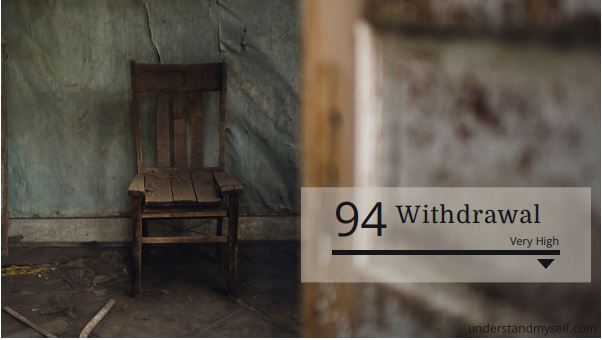Withdrawal: Very High
Withdrawal is an Aspect of neuroticism. The other Aspect of neuroticism is Volitility.
Withdrawal can be defined as the tendency to internalise negative emotions. In particular, withdrawal reflects the sensitivity of the behavioural inhibition system BIS which responds to conflicts between goals, especially approach and avoidance goals.
Your score puts you at the 94th percentile for withdrawal. If you were one of 100 people in a
room, you would be higher in withdrawal than 94 of them and lower in withdrawal than 5 of
them.
Individuals create a negative perception of themselves and the world and feel extreme anticipatory anxiety. This makes it much more challenging for them to approach new, uncertain, unexpected, threatening or complex situations. Instead, they are much more likely to avoid or withdraw in the face of the unknown and unpredictable.
People with high withdrawal are unusually likelier to feel sad, lonesome, disappointed and grief-stricken. They have very high levels of doubt and worry, become embarrassed quickly, are self-conscious and get discouraged rapidly in the face of threat and punishment. Their anticipatory anxiety is very likely to be general. They are susceptible to social rejection and can be easily hurt. Once hurt, frightened, or anxious, it also takes them a long time to recover. Perhaps people very high in withdrawal are highly concerned that something terrible might happen, while people very high in volatility (the other aspect of neuroticism) get very upset if something wrong does happen. Technically, withdrawal has been associated with activity in the brain systems that regulate passive avoidance.

